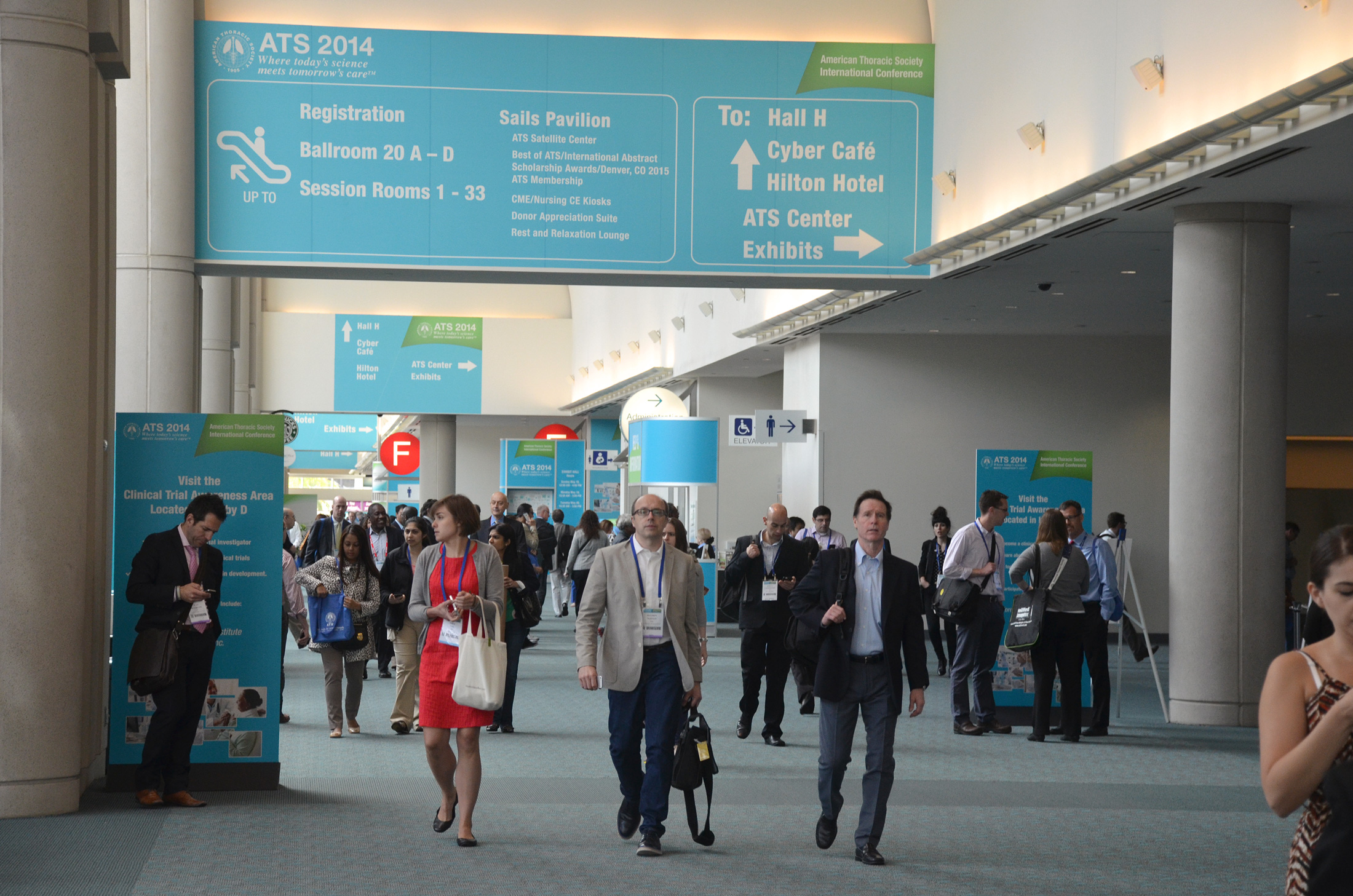Daily Business Report-Sept. 23, 2019
Artist’s rendering of the future USNS John Lewis. (Image courtesy of General Dynamics NASSCO)
NASSCO begins construction on first
ship in fleet oiler program for the Navy
General Dynamics NASSCO has began construction on the future USNS John Lewis, the first ship for the U.S. Navy’s John Lewis fleet oiler program. Representatives from NASSCO and the U.S. Navy gathered in San Diego on Friday for a ceremony to cut the first piece of steel, signifying the start of construction for the first of six vessels for the U.S. Navy.
Construction of the first ship is scheduled to be complete in November 2020.

The ship is named after Rep. John Robert Lewis, civil rights leader serving his 17th term in the House of Representatives for Georgia’s 5th congressional district.
Designed to transfer fuel to U.S. Navy carrier strike group ships operating at sea, the oilers will feature the capacity to carry 157,000 barrels of oil, a significant dry cargo capacity, aviation capability and a speed of 20 knots.
“These oilers are critical to the Navy’s ability to operate around the world,” said Kevin Graney, president of General Dynamics NASSCO. We are honored to build the lead ship of this class and have worked with our Navy and industry partners to ensure the design, planning, material and facility are ready to begin construction. ”
NASSCO is the largest shipyard on the West Coast of the United States conducting design, new construction and repair of ships. In the past decade, NASSCO delivered more than 30 ocean-going ships to government and commercial customers—including the world’s first LNG-powered containerships and several other lead ships.
______________________
Commentary:
Democrats want to kneecap ballot measures
By Dan Walters | CalMatters Columnist
Democrats own virtually every lever of government in California, including the governorship, both U.S. Senate seats, 46 of the state’s 53 congressional members, and three-fourths of state legislators.
However, they apparently want more.
For the umpteenth time, the Democrat-controlled Legislature has passed a measure clearly aimed at kneecapping the one remaining political process they don’t dominate — the power to place issues on the ballot via voter signatures on petitions.
Assembly Bill 1451, now awaiting Gov. Gavin Newsom’s signature or veto, would prohibit paying initiative, referendum, or recall petition circulators on a per-signature basis, and require 10 percent of signatures on an initiative petition to be collected by either unpaid circulators or the employees or members of nonprofit organizations.
Its author, Assemblyman Evan Low, a Campbell Democrat, and other advocates of the bill contend that it’s a good government measure to protect voters from being fooled by unscrupulous signature-gatherers who misrepresent the issues for which they are working.
But everyone familiar with the years-long effort to enact such a law knows that it’s an attack on the use of the ballot by business, politically conservative and/or anti-tax organizations trying to bypass the Legislature and seek voter approval of their proposals or to overturn laws that the Legislature has passed, or recall politicians.
It does not prohibit people from being paid to gather signatures, but they would have to be paid salaries, not on a per-signature basis, thus changing the dynamics of the process.
As former Gov. Jerry Brown said last year in vetoing a virtually identical bill by Low, per-signature is “often the most cost-effective method for collecting the hundreds of thousands of signatures needed to qualify a ballot measure.”
As governor, in fact, Brown had used per-signature petition circulators to qualify a couple of initiatives himself, including a hefty increase in state income taxes on the wealthy and the creation of a “rainy day” fund to protect the state budget.
The second major provision of AB 1451 is the requirement that 10% of signatures be collected by unpaid volunteers or the members or employees of a non-profit organization.
It’s a carveout that would help labor unions qualify their own measures for the ballot, which typically seek higher taxes, such as those that may appear on the 2020 ballot.
Since unions are technically non-profit organizations, they could hire as many signature-gatherers as they wish to collect signatures meeting the 10% requirement.
AB 1451 would not erase the initiative process, which was adopted by California in 1911 as a check on the power of a Legislature controlled by the Southern Pacific Railroad. But it would, by changing the rules of the game, disadvantage those on the right side of the political balance beam by making the process more expensive, while protecting those on the left side.
As mentioned above, it’s not the first time the game-changing maneuver has been tried.
Brown not only vetoed Low’s previous bill in 2018, but rejected similar measures in 2011 and 2016, and his predecessor, Republican Arnold Schwarzenegger, had done the same to bills in 2006 and 2009.
Now Newsom must decide whether to join Brown and Schwarzenegger in rejecting the perennial proposal, or finally give Democratic legislators and their union allies what they’ve yearned to gain for so many years.
It’s noteworthy that Newsom enhanced his own political career by sponsoring initiatives, including those to legalize marijuana and to impose new restrictions on guns and their owners.
CalMatters is a public interest journalism venture committed to explaining how California’s state Capitol works and why it matters. For more stories by Dan Walters, go to calmatters.org/commentary
______________________
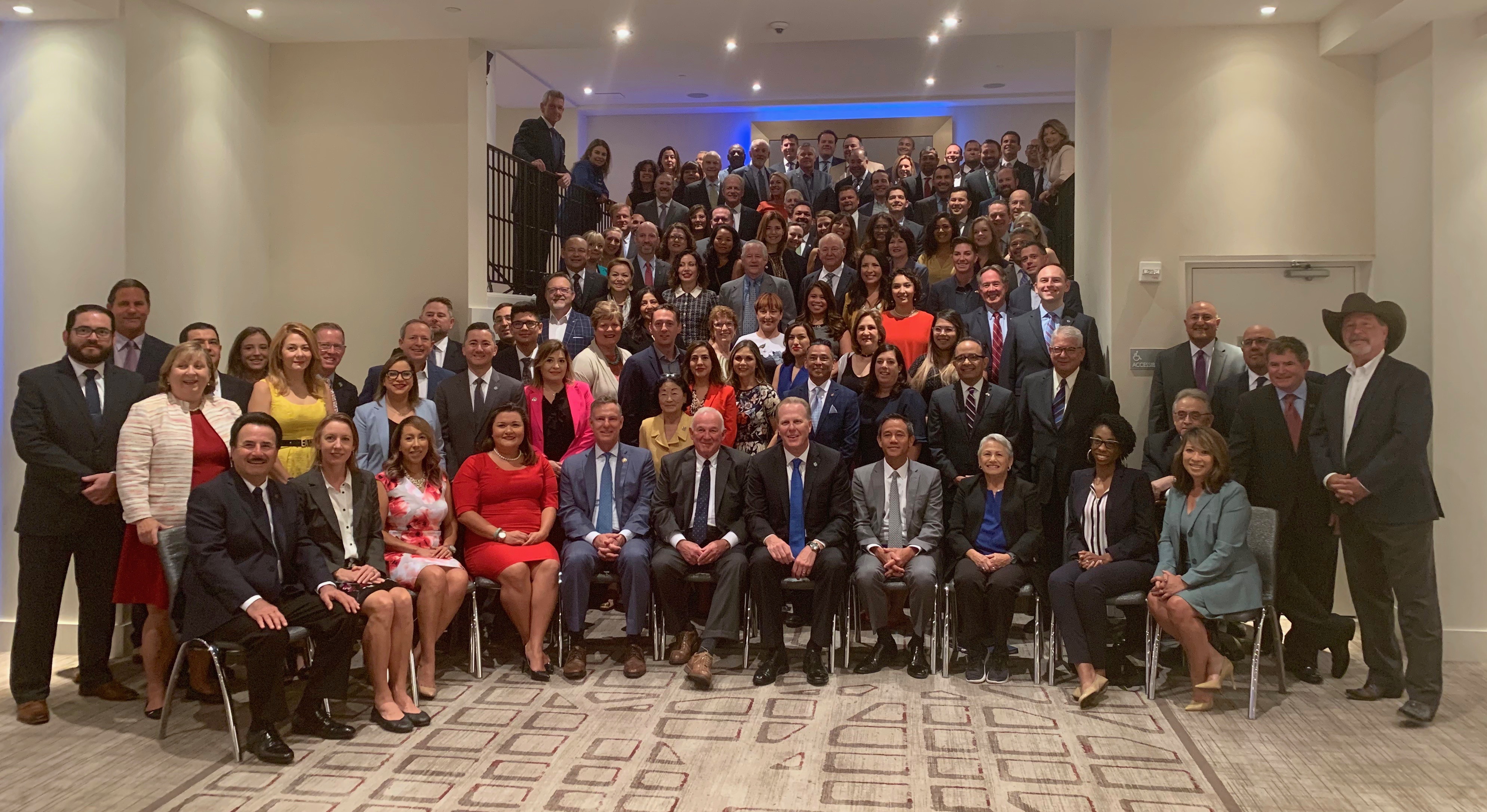
San Diego and Baja California leaders in
delegation headed for Washington, D.C.
A group of more than 160 business and civic leaders from San Diego and Baja California are headed to Washington D.C. to advance key issues related to jobs, commerce, and the regional economy. This is the largest group ever to take part in the San Diego Regional Chamber of Commerce’s annual “Mission to Washington D.C.” which brings delegates to the nation’s capital for three days.
The 162-member delegation represents a diverse mix of industries, organizations, and elected officials from both sides of the border including San Diego Mayor Kevin Faulconer, Tijuana Mayor Juan Manuel Gastélum, Encinitas Mayor Catherine Blakespear, Imperial Beach Mayor Serge Dedina, and Poway Mayor Steve Vaus. The delegation will meet with government officials, agency representatives, and policy makers to enhance understanding and advance policy that creates the best environment for businesses and neighborhoods to thrive.
Two issues of high importance during the trip are the Tijuana River Valley transboundary pollution and the ratification of the United States-Mexico-Canada Agreement.
______________________
Revised plan for replacement of airport’s
Terminal 1 includes a transit station
The San Diego County Regional Airport Authority released a revised draft environmental study for the Airport Development Plan (ADP), which envisions the replacement of Terminal 1 that would include a transit station that could connect to a people mover chosen by regional transportation agencies.
The Airport Authority said it will also launch an all-electric shuttle fleet that will carry transit riders from the Old Town Transit Center to the airport and back. This service is set to launch in early 2020.
The Airport Authority said it believes a strong connection to the region’s transit system is extremely important for its passengers, for the 9,400 people who work at the airport, and for overall traffic circulation in the area around the airport.
The designated transit station area will be able to accommodate whatever type of system is ultimately chosen by SANDAG and the other agencies.
The need for the Airport Development Plan has been fueled by the tremendous growth seen in passenger volumes. When Terminal 1 opened in 1967, it served 2.5 million passengers. In 2018, the same facility served more than 12 million.
The new Terminal 1 would be a more modern facility with up to 30 gates – 11 more than the existing Terminal 1. It would offer more gate-area seating, restaurants and shops, as well as additional security checkpoints with more lanes and a host of energy-efficiency upgrades.
A proposed on-airport access road would remove an estimated 45,000 cars per day from North Harbor Drive. The ADP also sets aside right-of-way for outbound lanes.
______________________
NAVWAR HQ one step closer to
becoming SD’s future transit hub
U.S. Navy Secretary Richard Spencer and officials with SANDAG signed a formal agreement to potentially revamp the Naval Base Point Loma Old Town Complex, which may be used as a transit hub to connect public rail transit to the Airport. The proposal would help modernize NAVWAR’s — the Navy’s R&D command — aging headquarters, increase local access to public transportation, and engage the midway district in smart development efforts. Read more.
______________________
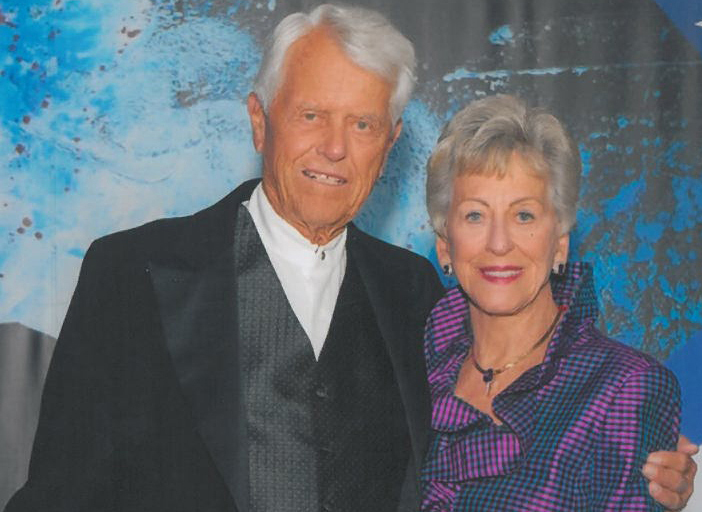
Malin and Roberta Burnham make $2.3 million
gift to Burnham-Moores Center for Real Estate
The Burnham-Moores Center for Real Estate (BMC) at the University of San Diego School of Business announced a $2.3 million leadership gift from real estate icon and San Diego native Malin Burnham, founder of Burnham Foundation, and his wife Roberta. The gift is provided to the BMC and will support School of Business real estate student scholarships, real estate faculty and the general mission of the center. Burnham is a long-time supporter of USD’s real estate program and serves as an emeritus policy advisory board member at the Burnham-Moores Center for Real Estate.
USD President James T. Harris III made the announcement about the Burnham leadership gift as part of the Burnham-Moores Center for Real Estate’s Campaign for 2020. The goal of the Campaign is to raise $10 million, which will serve the mission of the Burnham-Moores Center, including new scholarship endowment funds to attract the most qualified real estate students to USD and funding to enhance the ability to recruit and retain the nation’s top faculty in real estate. To date $3.4 million has been raised. Burnham’s gift will be leveraged to raise additional funds in support of the Campaign for 2020.
______________________
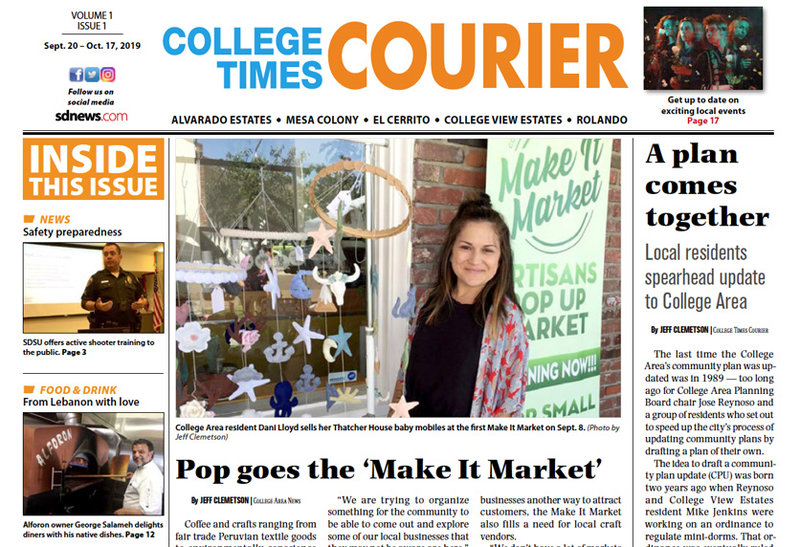
Newspaper group adds College Times Courier
to its group of publications
San Diego Community Newspaper Group has added a new publication — the College Times Courier. The new community newspaper will cover news from the College area and Rolando and will publish on the third Friday of every month.
“I feel this is a good addition to our community coverage of the east side of San Diego. It bridges the gap nicely between the Mission Times Courier to the north of Interstate 8 and east with La Mesa Courier,” said SDCNG publisher Julie Main. “There are a lot of school districts and shared interests between these well-established communities.”
The College Times Courier was created in response to community members and business leaders from the College Area who approached Main about returning coverage and distribution of the Mission Times Courier to the College Area.
The Mission Times Courier had previously distributed into College Area under publisher Jim Madaffer before he sold the paper to San Diego Community Newspaper Network (SDCNN) publisher David Mannis, who then consolidated coverage and distribution to the Navajo neighborhoods of Grantville, Allied Gardens, Del Cerro and San Carlos. Mission Times Courier, along with most of SDCNN’s publications, were acquired by SDCNG in March.
______________________

County receives $6.5 million federal
grant to strengthen local fight against opioids
In the midst of record-setting prescription drug deaths, the county of San Diego has received a $6.5 million grant from the Centers for Disease Control and Prevention to strengthen efforts in the local fight against opioids.
The grant, spread over three years, is part of a $1.8 billion national push by the federal Department of Health and Human Services to combat opioid addiction and deaths. The county of San Diego was one of 16 cities or counties to be awarded grants from this effort.
“The shape of the opioid epidemic is evolving and so must our approach in preventing the deadly and addictive impact of opioids in the county,” said Dr. Wilma Wooten, county public health officer. “This funding will help us take critical steps needed to help reverse the course of the growing opioid crisis.”
Set to be officially accepted by the Board of Supervisors on Sept. 24, the funds will be used to help prevent overdoses, develop systems that support coordinated and timely detections of potentially harmful events, provide training to providers, assist individuals in accessing drug treatment and recovery care, and provide guidance on education and training activities and in the use of electronic health records.
______________________
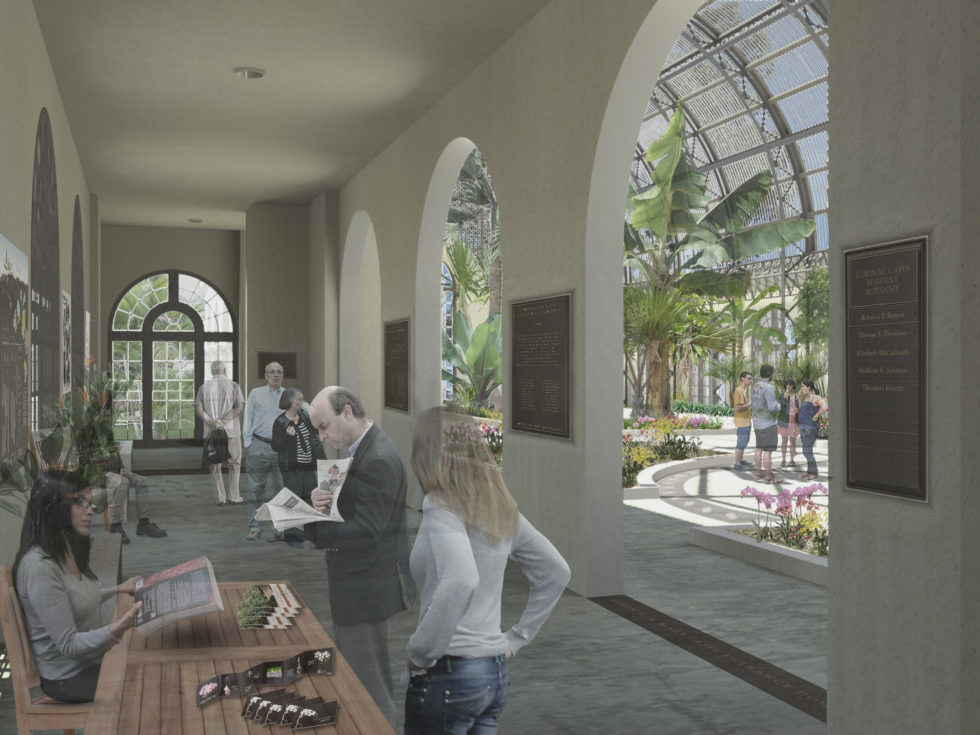
Balboa Park Conservancy receives grant for
restoration of Botanical Building welcome gallery
The restoration of the welcome gallery of Balboa Park’s iconic Botanical Building will be funded in part by a $257,668 grant from the Save America’s Treasures program, according to the Balboa Park Conservancy.
The federal Save America’s Treasures grant requires a dollar-for-dollar match in private donations. The Balboa Park Conservancy, the city of San Diego’s nonprofit partner that safeguards and cares for Balboa Park, will use the grant to restore the welcome gallery of the Botanical Building, which was built in 1915 for the Panama-California Exposition. Free to millions of annual visitors and home to more than 2,100 plant varieties, the building will soon undergo a major renovation.
The Botanical Building is in need of restoration due to termite damage, rust, and deferred maintenance. The total restoration project not only repairs and restores the facility and surrounding gardens, but provides new amenities, such as restrooms, water-efficient irrigation, energy-saving lighting, and enhanced opportunities for education, visitor engagement, and earned revenue.
______________________
Leukemia drug shows promise
for treating a childhood brain cancer
A drug used to treat chronic myeloid leukemia appears to be more effective at stopping a type of medulloblastoma in mouse models than existing treatments for the deadly pediatric brain tumor, reports a multi-institutional team led by researchers at Skaggs School of Pharmacy and Pharmaceutical Sciences at University of California San Diego.
In the study, published Sept. 20, 2019 in PLOS One, the team demonstrated how use of a single drug — in this case nilotinib — specifically targets cancer cells that have an abnormal activation of a cell communication system, called the Hedgehog pathway, via two different mechanisms, making it more effective and less toxic than combining drugs.
“We discovered a previously unknown activity of nilotinib that may be leveraged to treat a large fraction of cases of medulloblastoma, a type of childhood brain cancer,” said senior author Ruben Abagyan, professor in the Skaggs School of Pharmacy. “While more research is needed, this pharmaceutical could potentially be used for several cancer types with an overactive cell-signaling pathway.”
______________________
Hispanic real estate association lists
San Diego lineup for 19th annual convention
The National Association of Hispanic Real Estate Professionals announced the lineup for its annual 2019 NAHREP National Convention Sept. 26-29 at the Grand Hyatt in San Diego. The convention will host an estimated 5,000 real estate professionals, industry experts and corporate executives for four days of education, networking and entertainment.
Agenda highlights include:
- A Real Estate and Technology Executive Town Hall and a Lender Executive Town Hall, both of which will cover industry trends, planning strategies and the demands and opportunities of the Hispanic real estate market.
- A Latina Entrepreneur Brunch keynoted by Chef Pati Jinich, cookbook author and star of PBS show “Pati’s Mexican Table.” The event highlights Latinas as a primary force for the growth in Hispanic small business formation and features a panel of speakers.
- A panel of NBA athletes and professional sports executives, including former Phoenix Suns Head Coach Earl Watson and Heavyweight Champion, Andy Ruiz.
- The Elevate Sales Summit, an elite training program for professionals in the industry that features educational and inspirational presentations by C-level executives, industry experts, top producers and professional athletes.


